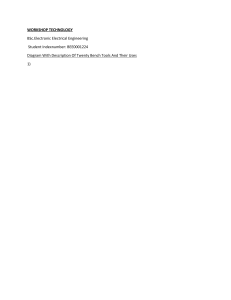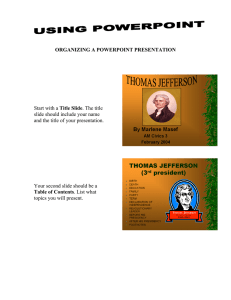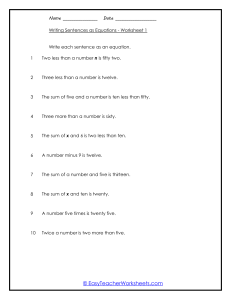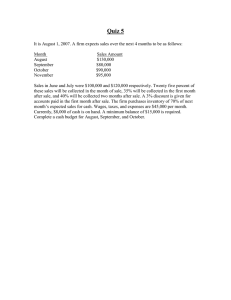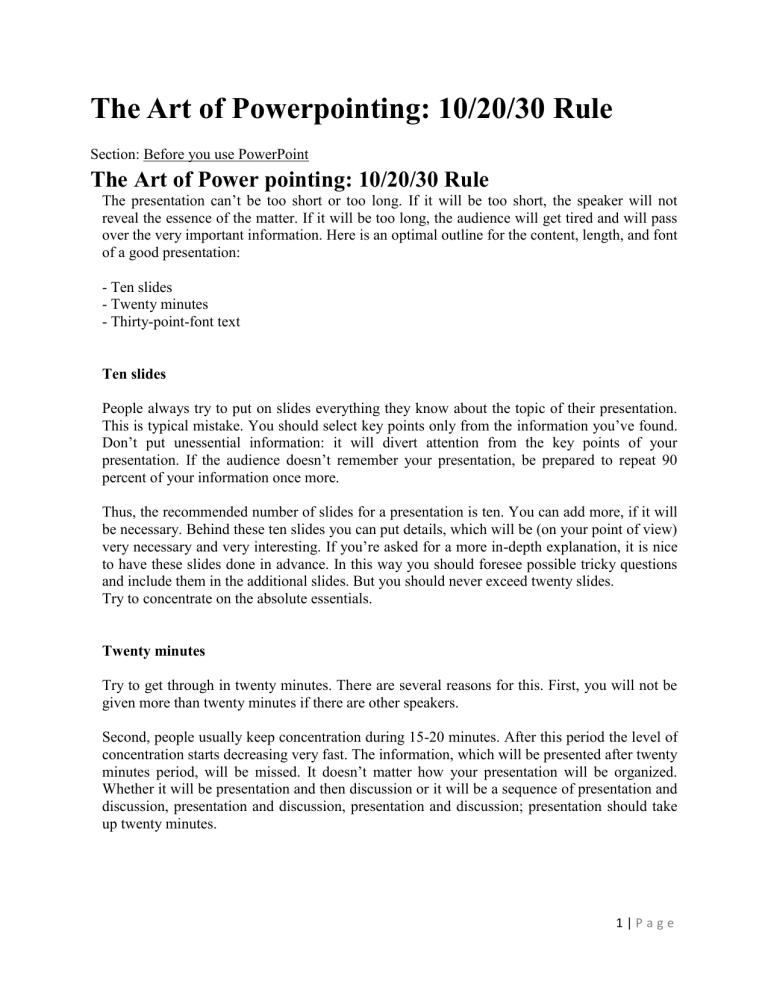
The Art of Powerpointing: 10/20/30 Rule Section: Before you use PowerPoint The Art of Power pointing: 10/20/30 Rule The presentation can’t be too short or too long. If it will be too short, the speaker will not reveal the essence of the matter. If it will be too long, the audience will get tired and will pass over the very important information. Here is an optimal outline for the content, length, and font of a good presentation: - Ten slides - Twenty minutes - Thirty-point-font text Ten slides People always try to put on slides everything they know about the topic of their presentation. This is typical mistake. You should select key points only from the information you’ve found. Don’t put unessential information: it will divert attention from the key points of your presentation. If the audience doesn’t remember your presentation, be prepared to repeat 90 percent of your information once more. Thus, the recommended number of slides for a presentation is ten. You can add more, if it will be necessary. Behind these ten slides you can put details, which will be (on your point of view) very necessary and very interesting. If you’re asked for a more in-depth explanation, it is nice to have these slides done in advance. In this way you should foresee possible tricky questions and include them in the additional slides. But you should never exceed twenty slides. Try to concentrate on the absolute essentials. Twenty minutes Try to get through in twenty minutes. There are several reasons for this. First, you will not be given more than twenty minutes if there are other speakers. Second, people usually keep concentration during 15-20 minutes. After this period the level of concentration starts decreasing very fast. The information, which will be presented after twenty minutes period, will be missed. It doesn’t matter how your presentation will be organized. Whether it will be presentation and then discussion or it will be a sequence of presentation and discussion, presentation and discussion, presentation and discussion; presentation should take up twenty minutes. 1|Page Thirty-point-font text It will be very difficult for the audience to read the text smaller than fourteen points. If you have to use a small font to present your information, it means that you are putting too much detail on the slide. Each slide should contain one key point. Use slides to lead, not read. They should paraphrase and enhance what speaker is trying to say. Because people can read faster than you talk, if you put too much detail on the slide, the audience will read ahead of you and not listen to what you’re saying. Outline a few words about the topic you are going to present, and then describe these few words in detail. This approach will be more effective than putting everything you know on the slide. Recommended reading Guy Kawasaki. The art of the start: the time tested, battle-hardened guide for anyone starting anything. New York: Penguin Group, 2004 Tips for Creating Readable Slides Section: Tricks, Tips, Problems, Fixes and Upgrades Tips for Creating Readable Slides This article gives you a few random tips and pointers that help you produce readable slides. Try Reading the Slide front the Back of the Room The number-one rule of creating readable slides is that everyone in the room should be able to read them. If you’re not sure, there’s one sure way to find out: try it. Put the slide in the projector, walk to the back of the room, and see whether you can read it. If you can’t, you have to make an adjustment. Five Bullets, Tops Ever notice that David Letterman uses two slides to display each of his Top Ten lists? Dave’s producers know that ten items is too many for one slide. Five is just right. Take a cue from Dave’s show and limit yourself to no more than five bullet points per slide. Avoid Small Text If you can’t read a slide from the back of the room, it’s probably because the text is too small. The rule of thumb is that 24 points is the smallest you should go for slides, and 18 points for overheads. Twelve-point type may be perfectly readable in a word processing document, but it just doesn’t cut it on an overhead or slide. 2|Page Avoid Excessive Verbiage Lending to Excessively Lengthy Text That Is Not Only Redundant but Also Repetitive and Reiterative. This heading could have been “Be Brief.” Get the point? Use Consistent Wording Whenever possible, be consistent in the way you word your bulleted lists. Consider this list: Profits will be improved Expanding markets We must reduce the amount of overseas competition Production increase Each sentence uses a different grammatical construction. The same points made with consistent wording have a more natural flow: Improved profits Expanded markets Reduced overseas competition Increased production See what I mean? Stick to the Color Scheme With all the professionally designed color schemes, there’s no reason to try to create your own. The color schemes combine colors that work well together. Why spoil the party? Stick to the Auto Layouts When You Can You can’t, at least not always. But try to if you can. The Auto Layouts include various placeholder objects that are already lined up for best readability. 3|Page Keep the Background Simple Don’t splash a bunch of distracting clip art on the background unless it is essential. The purpose of the background is to provide a well-defined visual space for the slide’s content. Avoid templates that have beach scenes in the background. For overheads, it’s best to use light-colored backgrounds. Dark backgrounds work well with slides. Use Only Two Levels of Bullets Sure, it’s tempting to develop your subpoints into sub-subpoints and sub-sub-subpoints, but no one can follow you. Don’t make your slides more confusing than they need to be. If you need to make sub-sub-subpoints, you probably need a few more slides. Keep Graphs Simple Microsoft Graph can create elaborate graphs that even the best statisticians will marvel at. But the most effective graphs are pie charts with three or four slices and column charts with three or four columns. If you remember only one rule when creating your presentation, remember this one: Keep it simple, clean, and concise. Ten Ways to Keep Your Audience Awake Section: Tricks, Tips, Problems, Fixes and Upgrades Ten Ways to Keep Your Audience Awake Nothing frightens a public speaker more than the prospect of the audience # W falling asleep during the speech. Here are some things you can do to prevent that from happening. Don't Forget Your Purpose Too many presentations ramble on and on with no clear sense of purpose. The temptation is to throw in every clever quotation and every interesting fact you can muster that is even remotely related to the purpose of your presentation. The reason that this temptation is so big is that you most likely haven’t identified what you hope to accomplish with your presentation. In other words, you haven’t pinned down your purpose. Don’t confuse a presentation’s title with its purpose. Suppose that you’re asked to give a presentation to a prospective client on the advantages of your company’s new, improved ChronoSimplastic Infindibulator. Your purpose in this presentation is not to convey information about the new Infindibulator, but to persuade the client to buy one of the $65 million beasties. The title of your presentation may be Infindibulators for the ‘90s, but the 4|Page purpose is to “convince these saps to buy one, or maybe two.” Don't Become a Slave to Your Slides PowerPoint makes such beautiful slides that the temptation is to let them be the show. That’s a big mistake. You are the show, not the slides. The slides are merely visual aids, designed to make your presentation more effective, not to steal the show. It’s tempting to dim the lights, hide behind the lectern, and let your slides do the talking for you. Keep the slides in their place. Don't Overwhelm Your Audience With Unnecessary Detail On November 19,1863, a crowd of 15,000 gathered in Gettysburg to hear Edward Everett, one of the nation’s most eloquent orators, speak for two hours about the events that had transpired during the famous battle. When Everett finished, Abraham Lincoln rose to deliver a brief twominute postscript that has since become the most famous speech in American history. If PowerPoint had been around in 1863, Everett probably would have spoken for four hours. PowerPoint practically begs you to say too much. After you get cranking on that outline, the bullets just fly, one after the other. Pretty soon, you have 40 slides for a 20-minute presentation. That’s about 35 more than you probably need. Try to shoot for one slide for every two to four minutes of your presentation. Don't Neglect Your Opening As they say, you get only one opportunity to make a first impression. Don’t waste it by telling a joke that has nothing to do with your presentation, apologizing for your lack of preparation, or listing your credentials. Don’t pussyfoot around; get right to the point. The best openings are those that capture the audience’s attention with a provocative statement, a rhetorical question, or a compelling story. A joke is OK, but only if it sets the stage for the subject of your presentation. Be Relevant The objective of any presentation is to lead your audience to say, “Me too.” Unfortunately, far too many presentations leave the audience thinking, “So what?” The key to being relevant is giving your audience what it needs, not what you think is interesting or important. The most persuasive presentations are the ones that present solutions to real problems rather than opinions about contrived problems. 5|Page Don't Forget the Altar Call You’ve spent hours putting your presentation together. Don’t forget to ask for the order. Invite your audience to respond and show them how. Make them an offer they can’t refuse. Tell ‘em your 800 number. Roll the pen across the table. Give the altar call. (The buses will wait.) Practice, Practice, Practice Somehow a rumor got started that Abraham Lincoln hastily wrote the Gettysburg Address on the train, just before pulling into Gettysburg. In truth, Lincoln agonized over every word of the address. Practice, practice, practice. Work through the rough spots. Polish the opening and the altar call and all the awkward transitions in between. Practice in front of a mirror or with a tape recorder. Time yourself. Don't Panic Don’t worry! Be happy! Even the most gifted public speakers are scared silly every time they step up to the podium. Whether you’re speaking to one person or ten thousand, relax. In 20 minutes, it will all be over. No matter how nervous you are, no one knows it except you. That is, unless you tell them. The number-one rule of panic avoidance is “Never apologize for your fears.” Behind the podium, your knees may be knocking hard enough to bruise yourself. But no one else knows. After you swab down your armpits and wipe the drool off your chin, people will say, “Weren’t you nervous? You seemed so calm!” Expect the Unexpected Expect things to go wrong because they will. The light bulb in the overhead projector will burn out. The microphone won’t work. You’ll drop your notes as you approach the podium. Who knows what else? Above All Else, Don't Be Boring An audience can overlook almost anything, but one thing they cannot overlook is being bored. Above all, you must never bore your audience. This guideline doesn’t mean that you have to tell jokes, jump up and down, or talk fast. Jokes, excessive jumping, and rapid speech can be as boring as formatting disks. If you obey the other commandments — if you have a clear-cut purpose and stick to it, avoid unnecessary detail, and address real needs — you’ll never be boring. Just be yourself and have fun. If you have fun, so will your audience. 6|Page

